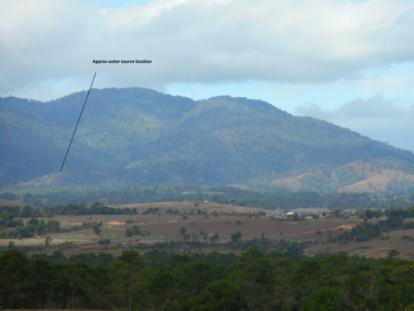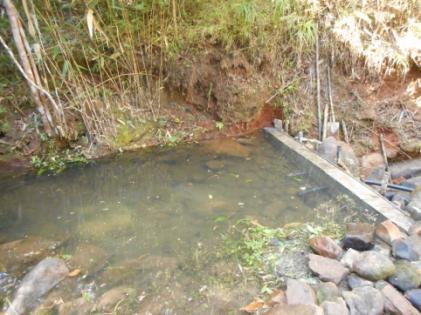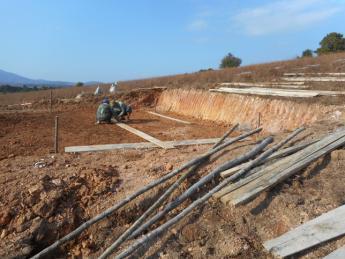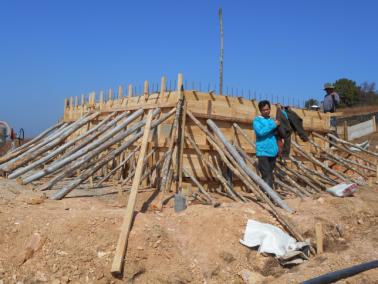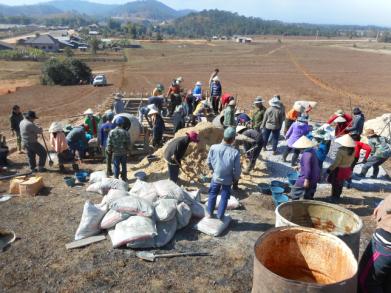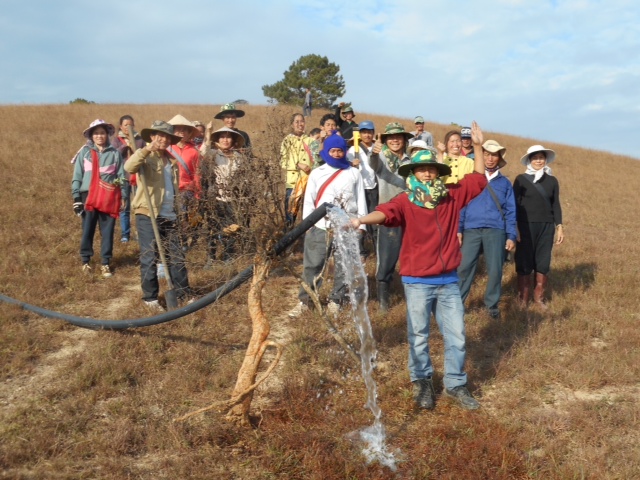Ban Naxaythong village was the first of the villages for which MiVAC provided running water in Lao PDR. It is about 25 km north of Phonsavan in Xieng Khouang Province, and had a population of around 1100 people.
There was no running water in the village, so water was either carted in by truck, or village girls and young women would carry 20kg containers of water, uphill, from water sources – which were several hundred metres or more from their homes.
A suitable water source was located, but it was almost 9km from the village. It was up in a creek in some small hills. But this meant that the water had to be transported the 9km to the village, including crossing one major creek.
METHODOLOGY
A small dam was constructed in the creek, with two 63mm diameter “poly” pipes carrying water to a small “settling tank”. The tank had three chambers, and as the water flowed up over one chamber wall and into the next chamber, any suspended dirt would drop to the bottom of the chamber. (The dirt could later be cleaned out using in-built cleaning lines.)
Then, a 63mm pipe was laid out, connected and buried 300mm below ground level (to prevent ultra violet light degradation) for the 9km to the village.
A 31,000 litre water holding tank was constructed on a small hill near the village, and the water flowed into this. Water the flowed through a number of smaller pipes to 11 water points located through the village, and with one of these at the school.
At all stages of the project, approvals and design assistance were sought from the District Government offices, and strong relationships were soon developed.
At the end of the work in this village, and once training in maintenance and sanitation, a formal handover ceremony was held. The Assistant District Governor and village Chief were both very pleased and appreciative of the work we completed.
A 94 year old man came up to me and told me it was the first time the village had ever had running water, and he was very happy. The women and girls were also very happy, as they now did not have to carry water over those long distances.
OUR PROJECT OBJECTIVES
The objectives of the project for the were,
- All inhabitants to have access to sufficient clean water for their daily needs;
- The village school to have water, toilet and hand-washing facilities within the school grounds;
- Villagers to receive health and hygiene instruction;
- Villagers to understand basic maintenance to enable sustainability of the water and sanitation systems and their water maintenance fund; and
- Village to set up and contribute monthly to their water maintenance fund.
These objectives were met, and a subsequent inspection in 2020 showed that maintenance had been undertaken on the pipeline, using village workers and funds from their water maintenance fund.
PROJECT DETAILS
Dates – Nov 2014 – Mar 2015
Funding – provided by grants from Rotary International, as well as from donations received by MiVAC.
Staffing – MiVAC’s volunteer Project Manager was Mr Brian Boon, MCS. Brian had a local man as Assistant Manager – Mr Moua , and Construction Carpenter – Mr No.
- Water source location (see base of black line), as taken from hilltop in Ban Naxaythong. The holding tank will be located on this hilltop
- Pipeline heading off into the distant hills
- Headworks tank – slab poured. Vertical reo added, and formwork being fabricated
- The weir at the water source. Note – two supply pipes used – due to likely supply flow rate to holding tank vs delivery flow rate to village. Inlet filters yet to be installed
- The finished headworks tank prior to placing roof slabs. Good clear water!!
- Area for tank excavated – initially by hand, but due to volume (16m3) & soil hardness (very), the villagers paid for an excavator – at no cost to project!
- Slab poured – 6m x 4m x 180mm – with starter bars for tank walls
- Steel reo tied, and formwork completed. Walls 1500mm high (above base) and 180mm thick
- Steel reo tied, and formwork completed. Big job in itself
- 75 villagers really going for it! We poured the concrete walls for the holding tank – 8m3 or 19 tonnes – in 2 hours using spades & buckets, with 2 concrete mixers going – can you believe they were so quick!!!
- Our concrete batching plants – fresh concrete emptied from mixers straight into “holding tanks”. Mixer then re-filled, while holding tanks emptied – all by spade & bucket
- The village Naiban – leading from the front as usual… That’s one BIG tank!
- Roof poured. Access panels also poured in situ over openings – clever concept
- Slab for first water point with first concrete batch in place, with more being mixed. The long “handle” shape coming towards camera is the diverting drain
- Some happy villagers/workers with first water flowing … Taps to be installed! Large size of concrete column – is to allow for cattle to rub against without damage!!
- Finished water point – with protective fence. Note the good velocity of water from tap, and also the hoses going to various houses
- 71 metre crossing. Anchor point poured at left of photo (0 metres); then concrete support post in photo centre; shear legs (at 43m point) on far bank; and another concrete support post and anchor at 71m point on far bank
- 63mm poly pipe in position attached to 14mm steel wire rope (SWR). UV protection for the pipe was provided by cutting lengthwise some 90mm poly pipe, and then attaching the upper half to the top of the 63mm pipe. The coils of both pipes then acted like a spring when released from the bridge, causing the pipe to wrap python like around the cable
- Mr Syamphay (Mr Water 2) conducting a session on the Health & Hygiene Training
- BB sitting at head table, with from left: Mr Sonephet (Mr Water 1), BB, Deputy District Governor (DDG), and one of the senior naibans from Naxaythong. Mr Soulisa speaking
- BB handing over the pipe wrench to the DDG
- DDG handing the wrench to the Naiban
- L to R – Mr Syon (PD 3IC), BB, Mr Syamphay (Mr Water 2), with Mr Soulisa (PD 2IC) playing keyboard in background. UXO survivor (missing fingers) serving rice whisky
- The water arrives in Ban Naxaythong


